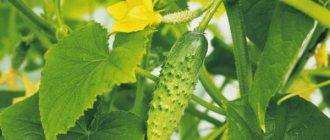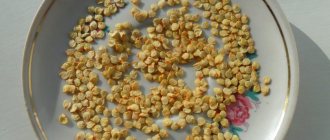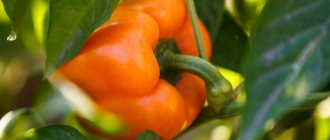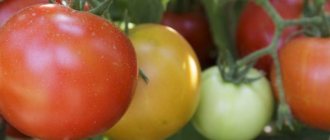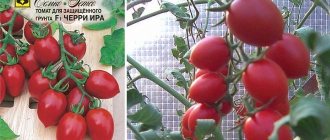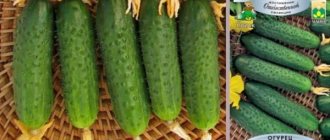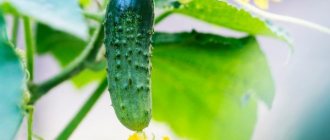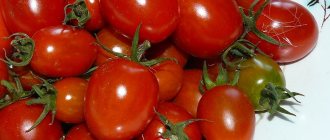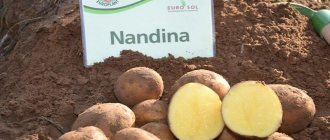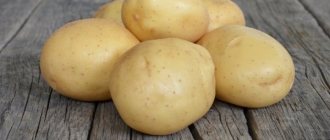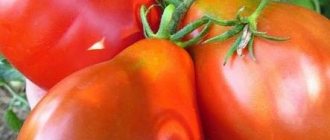History of the variety
Peppers of the Zvezda Vostoka F1 group were bred by the Russian breeding company SeDeK. This organization was founded in 1995 in the Moscow region and specializes in obtaining new hybrid vegetable crops. In cross section, the peppers look like a star, which is why the line of these hybrids received the appropriate name.
Star of the East F1 - a hybrid variety of domestic selection
Description of sweet pepper Star of the East F1
Sweet pepper is one of the most popular crops among gardeners. In addition to a large amount of vitamins and microelements, its fruits have a wonderful taste, which chefs like. For this reason, growing bell peppers in the garden is not uncommon. Let's look at the features that distinguish the Eastern Star variety.
Star of the East F1 is distinguished by large fleshy fruits and tall bushes
Characteristic features of the variety:
- Peppers of this series are grown in open ground, as well as in stationary or film greenhouses. Hybrids have an early or medium ripening period.
- The bushes are semi-spreading, powerful, 60–90 cm high.
- The fruits are cube-shaped. The wall thickness reaches 0.6–1 cm.
- The pulp is fleshy, tight, juicy. The aroma is weak.
- In a state of technical maturity, the fruits are light green in color (except for White in red and White in yellow); when fully ripe, they acquire the color characteristic of the variety.
- The variety is distinguished by large fruits weighing up to 240–350 g, distinguished by a variety of colors.
It is generally accepted that Star of the East F1 is a red-fruited variety, but there are several varieties . Each species has its own characteristics; the differences are only in the parameters of the fruit; in agricultural technology the techniques are the same.
Table: description of peppers from the Zvezda Vostok F1 line
| Hybrid | Color | Distinctive features | Ripening time | Productivity |
| Eastern Star Violet and Chocolate | The skin is glossy, dark purple or brown. | The weight of the peppers is 200–350 g, the wall thickness is 1 cm. | The growing season is 110–115 days. | 8–10 kg per 1 m2 |
| Star of the East Gold, Yellow, Orange and Tangerine | The skin is glossy, orange or yellow. | The height of the bushes reaches 80 cm. The average weight of peppers is 180–200 g, the walls reach a thickness of 0.7–1 cm. | Hybrids with early ripening periods of 105–110 days. | From 1 m2 you get up to 7.6 kg |
| Star of the East White in red and White in yellow | At the stage of technical maturity, the fruits are creamy-white in color; at biological maturity, they acquire yellow and red tints, respectively. | Weight - 150-200 g, walls - 8-10 mm. | Early ripening hybrids with a ripening period of 100–105 days. | Productivity - 7.5 kg per 1 m2 |
| Eastern Star Giant and Giant Red | The skin is glossy, rich scarlet color. | The bushes grow up to 90 cm. The weight of the peppers reaches 300–400 g. | Peppers with an average ripening period that lasts 120–130 days. | Productivity is 8–8.5 kg per 1 m2 |
Photo gallery: hybrid varieties of crops
Eastern Star Violet is famous for its unique colors
Star of the East White in Red - an early form of culture
Star of the East White in yellow is inferior in yield to other hybrids, but gives an early harvest
The Giant Star of the East is famous for its truly large fruits weighing up to 400 g
The Golden Star of the East grows on tall bushes
Star of the East Orange has a rich appetizing color and pleasant taste
The Tangerine Star of the East variety is brighter than the orange variety
Varieties
The traditional hybrid Vostok Star f1 produces dark red peppers. However, at the stage of technical maturity, they are colored milky-cream, which becomes redder as they ripen.
Usually, fruits are brought to biological ripening in order to collect seeds for subsequent cultivation. However, this is a hybrid, so there is no point in this, since such seeds do not have varietal characteristics.
All peppers in this series at the stage of technical and biological maturation have a distinctive color.
Purple
Doesn't give a big harvest. From 1 sq. per meter of planting, you can collect 6-7 kg of fruit. However, the peppers ripen early and have an exotic color.
At first they are dark purple, and when they reach biological maturity they acquire a dark cherry color. The wall thickness of the prismatic peppers is 7 mm. On average, one fruit weighs 180-300 g.
Chocolate
- It has an average ripening period.
- Gives a high yield - up to 10 kg per 1 sq. meters of landings
- The peppers are large, weighing about 270-350 g.
- The color of fruits at the stage of biological ripening is burgundy-brown. At technical maturity it is dark green in color.
- Has a peculiar peppery aroma.
Golden
- The fruits ripen at the same time.
- The yield is average - approximately 7.5 kg per 1 sq. meters of landings.
- Peppers weigh on average 175-200 g.
- The pulp is juicy, about 5-7 mm.
- At the stage of technical maturation they are dark green. When fully ripe they are bright yellow.
White
- The fruits are colored milky white only during technical ripening. When fully ripened on the bush, they become dark yellow and resemble a hybrid of White pepper in yellow.
- Productivity per square meter up to 8 kg.
- The thickness of the walls grows to 10 mm.
White in red
- It has cube-shaped fruits.
- At technical maturity they are white in color, gradually turning red as they mature.
- The yield is average, as is the wall thickness and weight of the peppers.
Red
- The fruits are prism-shaped.
- At the technical stage of ripening they have a dark green color.
- Has a faint peppery aroma.
Tangerine
- An unusual variety from this series, which produces up to 9 kg of peppers per 1 sq. meters of landings.
- The fruits are large, weighing on average 250-300 g.
- Peppers are initially dark green, but when fully ripe they become a deep orange hue.
- The pulp is juicy, about 8-10 mm thick.
- Nice peppery aroma.
Yellow
- Yellow and Orange Eastern Star differ in the color of the fruit, which appears at the biological stage of their ripening. Before this they are painted dark green.
- They ripen early.
- Indeterminate type of bush with unlimited growth.
- Up to 20 peppers can ripen on a bush together.
- The weight of each fruit reaches 160-180 grams. Although some specimens can gain weight up to 250 grams.
- Recommended for cultivation in heated greenhouses. Then 1 bush can bear fruit for a long time and will produce about 25 kg of fruit.
Gigantic
There are 3 varieties of the Eastern Star series, which have large fruits (up to 400 g) and an average ripening period:
- Gigantic.
- Giant red.
- Giant yellow.
The first 2 hybrids are very similar, but the last one differs in the color of the fruit.
- The bushes grow up to 100 cm in height.
- The yield is average - up to 10 peppers per bush.
Advantages and disadvantages of the variety
Star of the East F1 is a sweet, crunchy pepper with a lot of benefits. Breeders have created an almost ideal variety with only one drawback.
Table: strengths and weaknesses of the variety
| Advantages | Flaws |
| Good productivity (7–10 kg per 1 m2) | Pepper bushes need staking |
| Large fruit size (160 g) | |
| Pleasant sweet taste without bitterness | |
| High resistance to transportation | |
| Suitability of fruits for universal use | |
| Resistance to viral diseases |
Characteristics and description
East Star peppers were bred by breeders of the Russian company SeDek. The company was founded in 1995 and is engaged in the creation of new hybrid crops. The cut of the pepper resembles a star, hence the name.
Sweet peppers are a very popular garden plant. The fruits are rich in nutrients, and they are not difficult to prepare, so this variety is often chosen by chefs. So many people prefer to grow the Star of the East. Let's tell you how this culture differs:
- Peppers need to be transplanted into open soil, stationary or film greenhouses. The ripening period of hybrids is considered early or middle.
- It has semi-spreading bushes reaching 60-90 cm in height.
- The fruits are cube-shaped with a wall 0.6 - 1 cm thick.
- It has fleshy, dense and juicy pulp with a faint odor.
- Technically ripe peppers are light green, but when they are finally ripe their shade changes.
Star of the East is usually classified as a red-fruited variety, but different types of this pepper are known. Each has its own properties, but their main differences are only in the fruits. One agricultural technology is provided for the entire variety.
Advantages and disadvantages
Sweet crunchy peppers have many benefits. Experts have developed an almost perfect variety with just one negative feature.
Advantages of the Star of the East:
- excellent yield, 7-10 kg/sq.m;
- large fruit (weight 160 g);
- no bitter taste;
- ability to tolerate transportation well;
- widespread use of fruits;
- immunity to viral infections
There is only one inconvenience that may arise when growing this pepper: the bushes need to be tied up.
Landing Features
Seeds for seedlings are planted in the second half of February. To obtain healthy and strong seedlings, gardeners carry out preparatory measures. Let's look at the intricacies of planting peppers in more detail.
Planting of all F1 Star of the East hybrids is done the same way
Preparing seeds for seedlings
For sowing, material 1–3 years old is used. To select viable seeds, place them in a container, fill them with saline solution (40 g per 1 liter of warm water) for 10 minutes and mix. You can only use those that sink to the bottom. The remaining seeds are thrown away as unsuitable for sowing. Next, high-quality seeds are washed with running water and placed on a napkin or paper.
Important! Seeds are stored at a temperature of +10...+12 °C, otherwise their germination rate is reduced.
After the seeds have dried, treatment begins. This procedure reduces the likelihood of pepper being damaged by diseases and pests. The planting material is immersed in a solution of potassium permanganate (1 g per 1 liter of water) for 20–25 minutes, after which it is washed and dried again.
Next, the seeds are heated. To do this, they are placed in a fabric bag, which is placed in a thermos and filled with water at a temperature of +40...+50 °C for 2 hours. Warming up increases seed germination.
Important! If a thermos is not available, the planting material is kept for the same period of time in running water of a similar temperature.
Now the seeds are ready for sowing. If desired, another procedure is performed that will enhance germination:
- Planting material is soaked for 12 hours in a composition of 1 tbsp. l. ash, boric acid, which is taken on the tip of a knife, and 1 liter of water (+50 ° C).
- Then the seeds are washed, poured into bags and filled with a solution prepared from 1 liter of warm water (+26+28 °C) and 1 tsp for a day. the drug Agricola Vegeta, Effecton or potassium humate.
- After this treatment, seedlings will appear already on the 5th day.
Hardening will help strengthen the planting material . The seeds are wrapped in a moistened cloth or bag and placed for two days in a place where the temperature is maintained at +3...+4 °C. After this, they are kept for 24 hours at +18 °C.
Next, the material is again transferred to the cold for 48 hours. Finally, the seeds are germinated. To do this, they are placed on damp gauze or cloth and placed in a warm place. Sprouts appear after three days.
Before sowing seedlings, seeds must be prepared using appropriate methods.
Sowing pepper seeds
Seeds are sown in plastic rectangular containers with a volume of 250–300 ml. Gardeners also use ordinary plastic cups, but in this case the picking process will be difficult. The soil mixture can be purchased ready-made or prepared independently from the following components (one option to choose from):
- humus, sand, earth (2:1:1), add 1 tbsp per 1 kg of such substrate. l. ash;
- compost, soil, peat (1:1:1), 1 glass of wood ash;
- humus and peat (1:1);
- turf soil and humus (2:3);
- sawdust, peat, humus (1:2:2).
Sowing is carried out in the second half of February. The process itself goes like this:
- The seeds are planted in shallow containers measuring 8x8 cm. When filling the dies with substrate, leave a gap of 2 cm between the edges of the container and the soil surface.
- The soil is moistened with water at room temperature, then holes are made 1 cm deep at a distance of 3–4 cm, into which 1–2 seeds are placed.
- Then the seeds are sprinkled with soil to a maximum depth of 1 cm, compacted, covered with film to create a greenhouse effect and placed in a place with a temperature of +20...+25 °C. Water the substrate as the top layer dries.
Important! You should not place the container on the windowsill: exposure to drafts will negatively affect the development of seedlings.
When sprouts appear, the film is removed and the room temperature is reduced to +15...+17 °C. From 8 a.m. to 8 p.m., seedlings should receive light; natural light will not be enough for peppers. Therefore, special devices are installed near the plants at a height of 15–20 cm. These can be LED or fluorescent lamps with a power of 40–60 W.
Seeds are placed with minimal depth
Video: practical tips for sowing
Features of picking seedlings
At the stage of the appearance of two leaves (3–4 weeks after the formation of seedlings), the plants are planted in a container with a volume of 400–500 ml. These measures help prevent the development of root rot and also allow the seedlings to grow stronger. The soil for new containers is taken of the same composition in which the seeds were planted.
Picking promotes rapid growth of the root system and strengthening of seedlings
The process is performed in the following sequence:
- First, the soil in the die where the seedlings grow needs to be watered and wait until the water is absorbed. The sprout is taken by the stem, the substrate is lifted with a peg or a small plastic spoon, and then the plant with the earthen lump is transferred to a large container.
- In a new die, you need to prepare a hole in advance of such a size that the roots of the pepper can fit freely.
- Then the seedling is sprinkled with soil and compacted. The root collar is buried 0.5 cm.
Two weeks after transplantation, and then after a similar period of time, the seedlings are fed . To do this, use a solution of complex fertilizer, for example, Agricola (25 g per 10 liters of water).
Video: picking peppers
Transplantation into open ground
Pepper prefers well-lit places. It can be planted after cucumbers, onions, pumpkins, cabbage, zucchini, green manure, and carrots. But predecessors such as tomatoes, potatoes, eggplants and peppers should be avoided. Planting begins when the first buds begin to form on the seedlings, and it is important to observe the following conditions:
- The soil temperature should not be less than +15 °C.
- For peppers, choose light and fertile soil. These are chernozem, sandstones, loams.
- Soil acidity is within the pH range of 6–6.5.
Planting is carried out according to the standard scheme:
- Before planting, the soil in the selected area is dug up and fertilized with compost, peat or humus at the rate of 10 kg per 1 m2.
- Then the bed is leveled and holes are made, leaving 50 cm between them, and the rows are placed every 60 cm.
- If no preliminary soil preparation has been carried out, add 1 tsp into the holes. nitrophoska and handfuls of humus.
- The plant is removed from the container and moved into a hole with an earthen lump. The root collar of the seedling is placed at surface level.
- Then the hole is filled halfway with soil, then watered, spending a third of a bucket of water per bush, and the hole is completely filled with soil.
Transplantation into open ground is carried out only in well-warmed soil.
Video: master class on transplanting seedlings into the ground
Planting peppers
For sowing, special rectangular containers with a volume of 250-300 ml are provided. Instead, gardeners often take simple plastic cups, but then it will be difficult to plant seedlings. Planting is done in fresh or self-prepared soil, which can be 5 options:
- Humus with sand, earth, ash.
- Compost, soil, peat.
- Humus and peat.
- Turf soil and humus.
- Wood sawdust with humus and peat.
A convenient time for sowing is the end of February. It is done like this:
- The seeds are sown in small containers measuring 8*8 cm. A distance of approximately 2 cm is left between the edges of the cups and the soil.
- Add a little water at room temperature to the substrate, then make 1 cm indentations located 3-4 cm from each other. Planting material is placed there, 2 pieces each.
- The seeds are covered with a maximum of 1 cm of soil. To create a greenhouse effect, they are covered with film and placed in a room with a temperature of 20-25 degrees. When the top layer dries, watering is carried out.
It is not advisable to place a container with seedlings on a windowsill to avoid the negative effects of drafts.
When the sprouts appear, the film is removed and the room is cooled to 15-17 degrees. Every day from 8.00 to 20.00, seedlings should be illuminated, and not only by the sun's rays. Fluorescent or LED light bulbs with a power of 40-60 W are placed at a distance of 15-20 cm from the crop.
Further care of the plant
Pepper Star of the East F1 takes root well on the site, but certain care measures cannot be ignored. Therefore, after transplanting, you need to pay attention to watering the seedlings, fertilizing, tying up growing bushes, etc.
Proper watering of bushes
Pepper is a moisture-loving crop and requires regular watering. Do not irrigate peppers only during prolonged rains or downpours. Water the bushes using a watering can, evenly distributing the water under the roots. The work is performed in the morning before sunrise or in the evening. Make sure that the jet does not wash away the soil, exposing the root system.
Pepper is very sensitive to lack of moisture
Table: pepper watering schedule
| Period | Water consumption |
| 5 days after planting in the ground | 10 liters of water for 15 bushes |
| Once every 8–10 days before the first harvest | |
| When new flowers form |
Fertilizing to increase crop yields
Star of the East F1 will delight you with sweet large fruits with dense pulp, if you provide the required level of fertilizers during crop growth.
To form sweet and large fruits, peppers will need additional feeding.
Table: fertilizing peppers
| Application time | Nutrient elements | Norm |
| 15–20 days after planting in the garden | 5 g superphosphate, 10 g urea per 10 water | 1 liter of composition per bush |
| At the flowering stage | 1 tsp. potassium sulfate, 1 tbsp. l. superphosphate per 10 l | |
| At the stage of pepper ripening | 2 tsp each potassium and phosphorus per 10 l |
Hilling and garter
One of the conditions necessary for the full development of pepper is breathable soil . Therefore, in order to prevent the formation of a crust, the soil between the rows is loosened after rains and watering to a depth of 5 cm. When the height of the bush reaches 20 cm, the top is pinched. This accelerates the development of side shoots and, accordingly, will increase the yield.
After this procedure, several upper stems will form on the bush. Of these, the four strongest are left, the rest are cut off. If you do not pinch, then you need to regularly remove the stepsons. To prevent the bushes from breaking or deforming under the weight of the fruit, each plant is tied with twine to a peg, which is installed next to the pepper.
The Star of the East is a tall crop that needs a garter
Important! If the air temperature exceeds +30 °C, a shading screen must be installed over the beds, otherwise the pepper pollen will become unviable.
How to grow and plant seedlings
When the first shoots appear, the plant is placed on the windowsill. Small plants require a lot of light. During the day you need to maintain a temperature of 25 to 28 degrees. At night, the temperature can be reduced by three degrees. When 2 true leaves grow, the plants are transplanted into separate cups.
When replanting, pay attention to the roots; if they are too long, they will need to be plucked off by 1 cm. The boxes should not be moved from place to place. The plant is very sensitive to changes in its permanent location.
The plant is very sensitive to changing its permanent location.
Peppers are planted on the site in May. The timing depends on whether the bushes will be placed in open or closed ground:
- On May 5–10, peppers are planted in a greenhouse
- May 10 – 20, peppers are planted under film cover
- May 20 – 30, planting in open ground
In regions where summers are short, it is better to grow peppers in greenhouses; in open ground the fruits will not have time to set. If peppers are planted in open ground, you need to monitor the weather. If there is a risk of night frosts, the peppers need to be insulated; they are covered with film or lutrasil at night. Greenhouse peppers must be ventilated regularly.
Diseases and pests
Under favorable conditions, Zvezda Vostok F1 peppers demonstrate good disease resistance, but if agricultural practices are violated, dangerous diseases can develop.
Table: diseases affecting peppers
| Diseases | Signs | Treatment options | Preventive measures |
| Apical rot | The fruits become covered with watery spots and begin to rot. Sometimes the disease can only be detected by cutting the fruit (the flesh of the pepper rots). |
|
|
| Lythracnose | Brown spots appear on the roots, and the fruits become covered with watery spots and then fall off. | Spraying with a 1% solution of Bordeaux mixture. | Treating seeds in a solution of potassium manganese. |
| Blackleg | Rotting of the root part of the stem. | The diseased plant is removed, and the soil is treated with a solution of 3% copper sulfate. | |
| Alternaria blight |
| Treatment of plants with Bordeaux mixture and copper oxychloride (40 g per bucket of water). | Regular watering. |
Photo gallery: typical diseases of the variety
Alternaria most often appears in the first half of the growing season of the crop
Blossom blossom destroys pepper fruits
Lythracnose affects the root and above-ground parts of the bush
Blackleg leads to the death of the culture
Table: pests attacking crops
| Pests | Signs of defeat | Fighting methods | Prevention |
| Spider mite | Pests feed on the sap of the leaves, which leads to curling and drying. | Spraying bushes with Karbofos solution (60 g per 10 liters of water, consumption - 1 liter per 10 m2). | Cleaning the area from plant debris in the fall. |
| Aphid |
| Use of insecticides Karbofos, Keltan (1 tbsp per 10 l) or Fosbecid (5 ml per 10 l). | |
| Slugs | Pests eat leaves and damage fruits, leaving a silvery, slippery coating. | Spraying with Strela (50 g per 10 l). | Regular loosening of the soil and subsequent pollination of the bushes with dry mustard or ground hot pepper (1 tsp per 1 m2). |
Photo gallery: typical crop pests
Spider mites completely deplete leaves
Slugs eat leaves and fruits of the crop
Aphids suck the juice from the leaves, slowing down the development of the bush
Harvesting
The fruits of Star of the East F1 ripen in 105–130 days, depending on the variety. One bush produces 11–12 peppers. The harvest is harvested when the fruits reach technical maturity, when they acquire the appropriate size and shape, as well as when they are biologically ripe, which is characterized by a certain color.
Peppers are harvested once every 6–7 days, cutting off the stalks, this will extend the storage period . The harvest is stored in baskets, bags or boxes at +8...+10°C and humidity 80–90%.
Peppers of the Zvezda Vostok F1 variety have a sweet taste without bitterness. They can be frozen, dried, canned, used to prepare vegetable caviar, soups, side dishes, or eaten fresh.
Star of the East F1 is a universal variety, suitable for both fresh consumption and baking or canning.
Reviews from summer residents
Amateur gardeners have very well received the hybrid varieties “East Star”. They highly appreciated the yield and early ripening of fruits. It is noted that the fruits have time to ripen in open ground and do not require cultivation in greenhouses. With good care, it was possible to obtain up to 20 peppers from a bush.
Interesting! A three-meter bed with two rows of planting can provide a sufficient harvest for one family.
Summer residents speak well of the taste of peppers and note the long-term preservation of the crop. Among the shortcomings, the only thing noted is that the branches cannot withstand the load of fruit and break. The seeds of these varieties are in high demand among vegetable growers.
